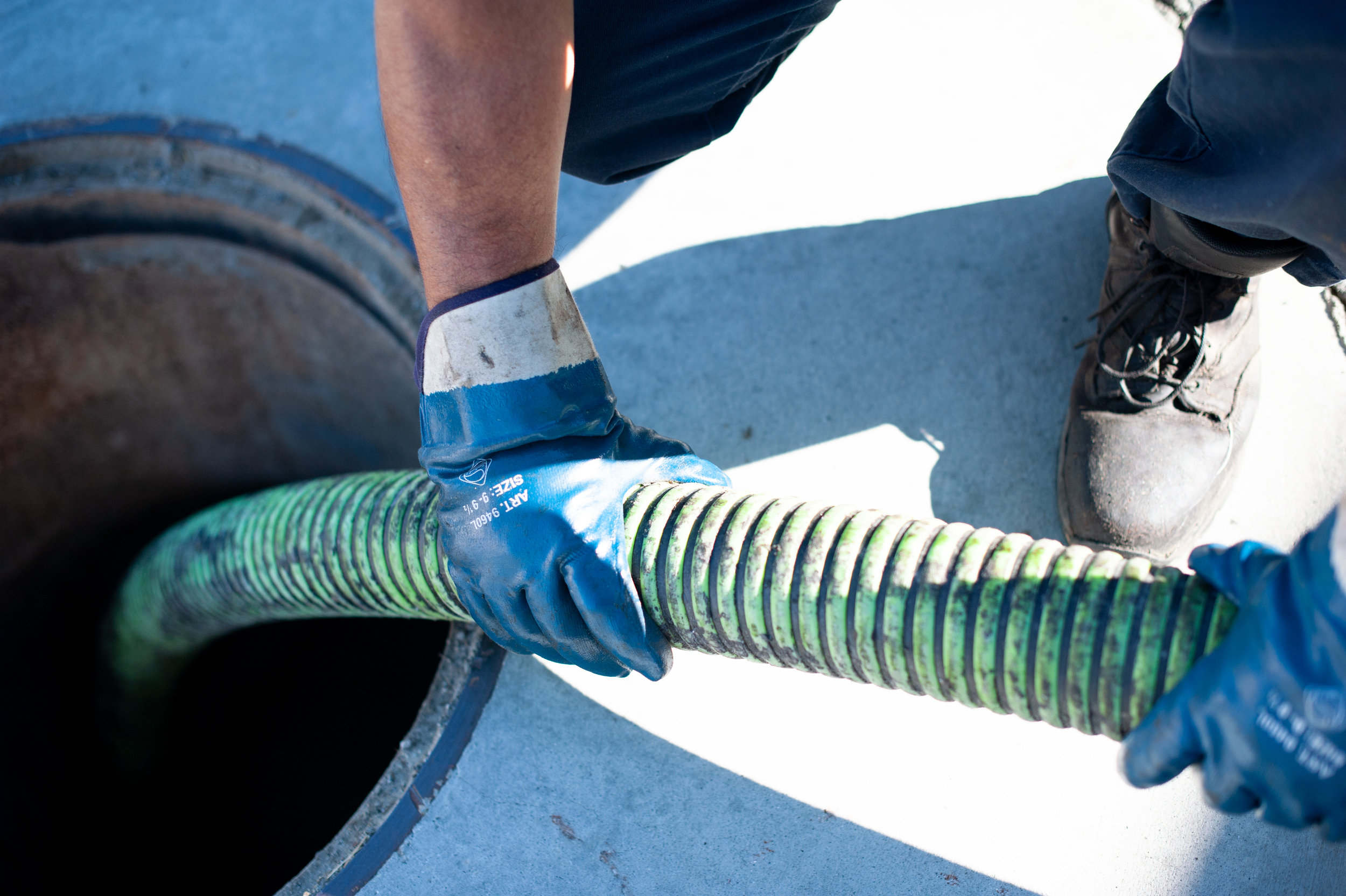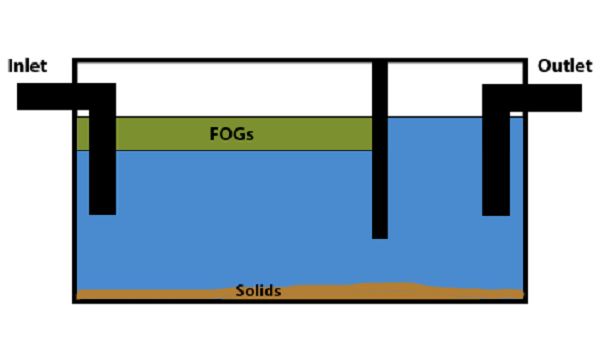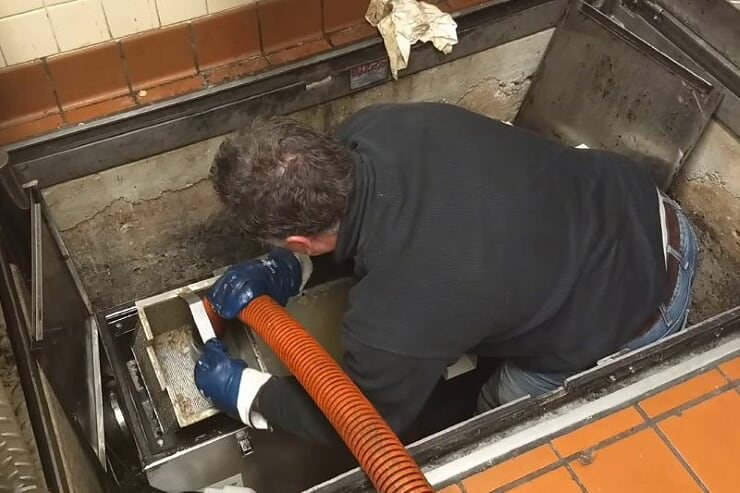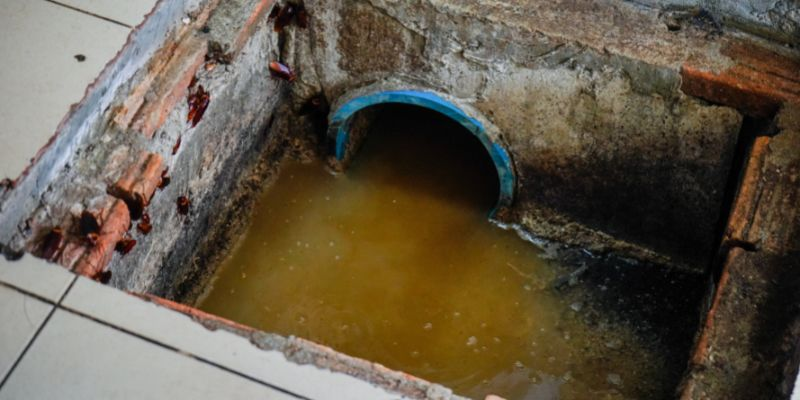
A clean and well-maintained grease trap is essential for preventing unpleasant odors, obstructions in sewer lines, and unsanitary water accumulations in commercial kitchens. Neglecting proper grease trap maintenance can lead to grease trap waste and sediment buildup, potentially causing blockages in the water outlet or contaminating the city sewer system. Therefore, it’s crucial to engage professional grease trap cleaning services to ensure the smooth operation of your commercial kitchen.
Not only do grease trap cleaning services help maintain a clean and efficient kitchen environment, but they also protect sanitary sewer lines from blockages and overflows. By performing a regular grease trap clean, you can prevent such issues, safeguarding the health of your staff and customers, as well as the environment.
In the next sections, we’ll dive deeper into how grease traps work and the risks associated with grease trap overflows.
Grease traps are specifically designed to intercept FOG (fats, oils, and greases) and food solids, preventing sewer line backups. Typically located outside the main building or in the basement, a commercial grease trap plays a crucial role in maintaining a clean and efficient kitchen. Cleaning grease traps regularly is essential to maintain their functionality.
To clean a grease trap, one can scrape its interior or use a shop vacuum to extract smaller pieces of waste lodged in hard-to-access areas. A steel pot scrubber, soap, and water are recommended for the cleaning process. Lastly, flushing the screens and components with water helps remove soap and residual waste, ensuring proper grease trap maintenance.
Grease trap overflows can result in a myriad of issues, including damage to the grease trap system, plumbing problems, and unpleasant odors. Additionally, overflows can contaminate drinking water, expose people to hazardous chemicals, and spread disease. Environmental damage can also occur, such as contaminating rivers and streams, destroying aquatic life, and releasing toxic gases into the atmosphere.
Thorough cleaning of the grease trap, including its parts, can help prevent problems such as clogged pipes, backed-up drains, and overflowing toilets. Proper maintenance and cleaning also help prevent water contamination and the spread of disease-causing bacteria.
In the next section, we’ll discuss how to choose the right grease trap cleaning service to ensure the best possible outcome for your establishment.

Selecting the right grease trap cleaning service requires careful consideration of factors such as certification, licensing, adherence to regulations, and eco-friendly practices. By choosing a qualified and experienced service provider, you can ensure the highest quality grease trap cleaning while complying with local regulations and protecting the environment.
Researching the company and confirming that they are certified, licensed, and adhering to regulations is essential when selecting a grease trap cleaning service. Additionally, it’s crucial to verify that the company uses eco-friendly practices and is proficient in providing the required services.
In the next subsections, we’ll delve deeper into these considerations for choosing the right grease trap cleaning service.
Certification and licensing for grease trap cleaning services are paramount to guarantee that the service provider is competent and authorized to carry out the job securely and proficiently. It may also be mandated by local regulations. Ensuring that a grease trap cleaning service has certified personnel and the necessary licensure is a crucial criterion for selecting the right provider.
A grease trap cleaning service provider with certified professionals and proper licensing can guarantee a high-quality grease trap service and adherence to regulations. By choosing a certified and licensed provider, you can have peace of mind knowing that your grease trap will be cleaned effectively and safely, minimizing the risks of overflows and other issues.
A grease trap cleaning service provider should adhere to stringent health and safety protocols and applicable local regulations. Regulations may mandate establishments to maintain their grease traps adequately and have them cleaned every 90 days, or according to state and local guidelines specifying the minimum depth and capacity of grease traps.
Adherence to strict health and safety guidelines and local regulations is paramount when choosing a grease trap cleaning service. Compliance with these regulations not only ensures the proper functioning of your grease trap, but also protects the environment and public health.
To ensure minimal environmental impact, it’s crucial to choose a grease trap cleaning service provider that uses environmentally friendly methods for grease trap cleaning. Avoiding the use of chemicals or pipe cleaning methods that may be detrimental to the environment or the grease trap itself is of utmost importance.
Eco-friendly techniques for grease trap cleaning protect the environment and prevent potential damage to the grease trap system. By choosing a service provider that employs environmentally friendly practices, you can contribute to a cleaner and safer environment while maintaining an efficient commercial kitchen.

The grease trap cleaning process involves full evacuation, water cleansing, and double emptying without the use of chemicals or pipe cleaning. By opting for a grease trap cleaning service that follows this procedure, you can ensure the thorough cleaning of your grease trap while minimizing the risk of environmental harm or damage to the trap itself.
Full evacuation of the grease trap ensures that all waste is removed, preventing potential overflows, backups, and other issues. Water cleansing and double emptying help to thoroughly clean the grease trap and eliminate any residual debris.
In the following subsections, we’ll discuss each step of the grease trap cleaning process in more detail.
Full evacuation of a grease trap involves the complete removal of all grease and waste material from the trap. This process should be carried out by a professional grease trap cleaning service to guarantee all waste is eliminated. Full evacuation ensures the complete removal of all waste from the grease trap, averting potential overflows or backups and helping to maintain a safe and hygienic environment.
Failure to execute full evacuation could result in grease trap overflows or backups, which could lead to environmental contamination, plumbing system damage, and potential health hazards. To avoid these risks, it’s crucial to engage a grease trap cleaning service that follows a thorough full evacuation process.
Water cleansing and double emptying are essential steps in the grease trap cleaning process. This process involves emptying the trap twice to ensure all grease and waste is completely removed, followed by flushing with water to eliminate any residual debris. By implementing water cleansing and double emptying, you can ensure a complete and thorough clean of your grease trap.
The intent of water cleansing and double emptying is to guarantee that no waste remains in the grease trap, preventing potential overflows, backups, and other issues. This thorough cleaning process maintains the efficiency of your grease trap and contributes to a cleaner and safer commercial kitchen environment.
Refraining from utilizing chemicals or pipe cleaning methods that can detrimentally impact the environment or harm the grease trap is of utmost importance when cleaning your grease trap. By avoiding these harmful methods, you can contribute to the protection of the environment and prevent potential damage to your grease trap system.
Using chemicals or pipe cleaning methods when cleaning a grease trap could have a detrimental effect on the environment and may cause damage to the grease trap. By choosing a grease trap cleaning service that employs eco-friendly practices and avoids harmful methods, you can ensure the health of your grease trap and its surroundings.

Grease trap maintenance tips include regular inspections, proper disposal of waste, and keeping records. By following these tips, you can ensure the efficient functioning of your grease trap and promptly identify and address any potential issues.
In the next subsections, we’ll explore each of these maintenance tips in more detail. Regular inspections of your grease trap can help prevent blockages, clogs, and other issues, improving kitchen sanitation and ensuring adherence to regulations.
Proper disposal of waste from your grease trap is essential to prevent contamination and environmental harm. Keeping maintenance records is necessary for compliance purposes and guarantees the efficient functioning of your grease trap.
Scheduling regular inspections for grease traps is essential to ensure proper functioning and identify any issues in a timely manner. Periodic inspections can help avoid blockages and clogs, improve kitchen sanitation, ensure adherence to regulations, preserve the effectiveness of the grease trap, and reduce expenses.
By performing regular inspections, you can monitor the state of your grease trap and take action if necessary. This proactive approach can save you time and money in the long run, as well as contribute to a cleaner and safer kitchen environment.
Proper disposal of waste from your grease trap is crucial to maintaining a clean and efficient kitchen environment. The recommended disposal methods for grease trap waste may vary according to local regulations and guidelines. Common disposal methods include manual removal, direct land application, and landfilling.
By disposing of waste responsibly and in accordance with local regulations, you can prevent contamination of the environment and safeguard public health. Furthermore, proper waste disposal helps maintain the efficiency of your grease trap and contributes to a cleaner and safer commercial kitchen.
Maintaining records of grease trap cleaning and maintenance is essential for compliance purposes. Records should include the date of cleaning, the quantity of grease removed, and the name of the company that conducted the cleaning. Establishments are also required to maintain records of grease trap cleaning on the Grease Control Log, using the Grease Interceptor Cleaning Report Form and the Grease Trap Cleaning Report Form.
By keeping detailed records of grease trap maintenance, you can ensure adherence to regulations and track the performance of your grease trap over time. This information can help you identify potential issues early on and take action to maintain the efficiency of your grease trap system.

Signs that your grease trap may need replacement include municipal inspection failures, constant backups, ineffective grease filtering, difficult cleaning, or persistent bad odors. If you notice any of these signs, it’s crucial to consult a professional grease trap cleaning service to assess the condition of your trap and determine if replacement is necessary.
Replacing a malfunctioning grease trap can prevent further damage to your plumbing system, protect the environment, and maintain a clean and efficient commercial kitchen. By monitoring your grease trap closely and addressing issues promptly, you can ensure the longevity of your grease trap system and contribute to a cleaner and safer kitchen environment.
In conclusion, grease trap cleaning services play a pivotal role in maintaining an efficient and sanitary commercial kitchen. By choosing the right service provider, understanding the cleaning process, and following essential maintenance tips, you can prevent potential issues and ensure the longevity of your grease trap system. Remember to prioritize certification, licensing, compliance with regulations, and environmentally friendly practices when selecting a grease trap cleaning service. With the right knowledge and proactive approach, you can contribute to a cleaner, safer, and more efficient commercial kitchen environment.
Call and set up a grease trap service today 602-777-7867 Sewertime Septic & Drain